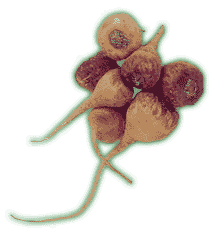
Back عشبة الماكا Arabic عشبة الماكا ARZ Lepidium meyenii AST Lepidium meyenii Azerbaijani Ҡандалагөл Bashkir Lepidium meyenii Catalan Lepidium meyenii CEB Řeřicha peruánská Czech Maca (Pflanze) German Μάκα Greek
| Lepidium meyenii | |
|---|---|

| |
| Maca hypocotyl and root | |
| Scientific classification | |
| Kingdom: | Plantae |
| Clade: | Tracheophytes |
| Clade: | Angiosperms |
| Clade: | Eudicots |
| Clade: | Rosids |
| Order: | Brassicales |
| Family: | Brassicaceae |
| Genus: | Lepidium |
| Species: | L. meyenii
|
| Binomial name | |
| Lepidium meyenii | |
| Synonyms | |
|
Lepidium peruvianum | |
Lepidium meyenii, known as maca or Peruvian ginseng, is an edible herbaceous biennial plant of the family Brassicaceae that is native to South America in the high Andes mountains of Peru and Bolivia. It was rediscovered for commercial purposes at the Meseta de Bombón plateau close to Lake Junin in the late 1980s.[1] It is grown for its fleshy hypocotyl that is fused with a taproot, which is typically dried, but may also be freshly cooked as a root vegetable. As a cash crop, it is primarily exported as a powder that may be raw, or processed further as a gelatinized starch or as an extract. If dried, it may be processed into a flour for baking or as a dietary supplement.
Its Spanish and Quechua names include maca-maca, maino, ayak chichira, and ayak willku.
- ^ Hermann, M, Bernet T. "The transition of maca from neglect to market prominence: Lessons for improving use strategies and market chains of minor crops." Agricultural Biodiversity and Livelihoods Discussion Papers 1. Bioversity International, Rome, Italy, 101 p., 2009.